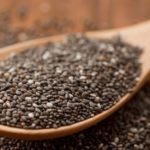Turnips

Turnips are a type of vegetable that is typically planted in the fall and harvested in early winter. Eating them during this time ensures that you avoid consuming any pesticides that may have been sprayed on the crop. Moreover, turnips are a root vegetable, so they are not susceptible to insect damage, and even if there are insects on the leaves, it doesn’t affect the turnips themselves. Additionally, the spicy taste of turnips is unappealing to insects.
This vegetable is also known as the “winter ginseng,” and it offers a range of health benefits, including cancer prevention, immune system enhancement, anti-inflammatory properties, and weight loss support.
Lotus Root

Lotus root is the edible rhizome of the lotus plant (Nelumbo nucifera).
Lotus root has a subtle sweetness, reminiscent of chestnuts, with an appealing flavor and a texture similar to potatoes. Due to its appealing crispness when cooked, lotus root is a versatile ingredient in the kitchen, suitable for stir-frying, boiling, steaming, deep-frying, and stewing.
In addition, this food is used to make lotus root starch, or it can be sliced and dried to be used as a medicine in traditional medicine (lien nguu). Thus, lotus root is known not only as a food but also for its numerous health benefits.
Lotus roots are grown in water, mainly by absorbing nutrients from the mud. The lotus plant does not require the use of pesticides.
There is a saying, “Lotus is a treasure,” and it is believed that lotus root is especially beneficial during the fall and winter seasons. Therefore, lotus root is considered very safe and suitable for the elderly and children during these seasons.
This versatile root can be eaten raw or cooked in various delicious dishes. However, there is a difference between lotus roots with seven holes and those with nine holes. Depending on your intended use, choose the appropriate type to maximize its benefits.
Typically, lotus roots have either seven or nine holes, and experienced lotus growers can tell you that there is a significant difference between the two. The seven-holed lotus root has a brownish-yellow exterior, is short and stout, and has a bitter taste when eaten raw due to its high starch content and low water content. In contrast, the nine-holed lotus root has a silvery-white exterior, a smooth skin, and an elongated shape. It has a sweet and crispy taste, making it ideal for salads and stir-fries.
A useful tip for shoppers is to choose lotus roots with larger, shorter segments. These roots will have the ideal level of ripeness and the best flavor. Select intact roots with no signs of bruising or water damage. If a lotus root is not whole, do not purchase it, as it may contain parasites or bacteria.
Check for the presence of moist mud on the exterior. If there is no mud, it indicates that the lotus root has been processed and may not keep fresh for long. On the other hand, lotus roots with moist mud on their surface can stay fresh for up to a week.

Delicious and nutritious lotus root dishes. Illustration.
Speaking about the benefits of lotus root, TS. Luong Y Phung Tuan Giang, Chairman of the Institute for Research and Development of Vietnamese Traditional Medicine, shared the following with Dai Bieu Nhan Dan:
– Beauty Benefits: Lotus root is an excellent source of vitamin C, which, along with its antioxidant properties, benefits the skin in multiple ways. Vitamin C promotes collagen synthesis, protects the skin from free radical and UV damage, and helps reverse signs of aging. It also helps reduce hyperpigmentation and evens out skin tone.
– Brain Health: Lotus root is considered a good source of the trace element copper. Copper not only boosts energy levels, strengthens bones, and supports metabolism but also enhances brain health by activating neural pathways. Research suggests that a deficiency in copper may be linked to the onset of neurodegenerative diseases like Alzheimer’s. Including lotus root in your diet can help prevent cognitive decline.
– Cardiovascular Health: Lotus root is rich in nutrients and fiber, which contribute to better cardiovascular health. Studies have found an inverse relationship between the consumption of insoluble fiber and both blood pressure and cholesterol levels. Additionally, lotus root is a good source of potassium, which is essential for maintaining a healthy heart rhythm. Individuals with low potassium levels are at a higher risk of heart disease, particularly stroke.
– Immune System Boost: Lotus root provides a good amount of vitamin C, which acts as an antioxidant in the body and strengthens the immune system.
– Energy Boost: Regular consumption of lotus root is beneficial for overall health. It helps increase iron levels in the body. Iron supports sustained energy by ensuring that oxygen is delivered to the body’s cells. When we are deficient in iron, we often feel tired, weak, and unable to focus. Eating iron-rich foods helps increase oxygen levels in cells and muscles, enhances protein digestion, and improves nutrient absorption from food.
– Nutritional Value: 100g of fresh lotus root contains 79.1g of water and provides 74 kcal of energy. It is also a good source of essential nutrients like calcium, iron, magnesium, sodium, zinc, and protein. The vitamin C and fiber content in lotus root are particularly beneficial for individuals with weak constitutions, liver ailments, constipation, and diabetes.
Safe Vegetable, Fruit, and Herb Washing Techniques
Medical experts advise that if vegetables, fruits, and herbs are not washed correctly, they may still harbor harmful bacteria.
For thicker-skinned produce, a toothbrush can be used to remove dirt and bacteria.
To protect your health, thoroughly washing vegetables, fruits, and herbs is the best way to reduce the risk of foodborne illnesses.
Here are some safe handling practices to follow before consuming these foods:
– Wash your hands thoroughly with soap and warm water before and after preparing meals.
– Regularly clean kitchen surfaces, cutting boards, and knives with warm water and soap after peeling and before cutting vegetables, fruits, and herbs.
– Never wash vegetables, fruits, or herbs with soap or detergent. Use only potable water for rinsing.
– For produce with thick skins, such as potatoes or cucumbers, use a clean toothbrush to scrub away any dirt or bacteria that may be present.
– For vegetables with multiple crevices, such as broccoli or leafy greens, soak them in cool, clean water for 1-2 minutes.
– Conversely, for delicate-skinned produce like tomatoes or berries, avoid soaking them in water. Instead, place them in a colander or basket and gently spray them with clean water.
– Once your vegetables, fruits, and herbs are clean, you can use a clean paper towel to dry them, which will help remove any remaining bacteria and prevent the produce from becoming soggy.
According to Nguoi Dua Tin
8 Common Mistakes People Make with Cutting Boards
Are you using your cutting board correctly? Many Vietnamese households rely on cutting boards in their kitchen, but not everyone knows how to use them properly, especially when it comes to wooden cutting boards. Check out these 8 mistakes to avoid when using a cutting board to ensure both hygiene and safety for everyone in your family.







































